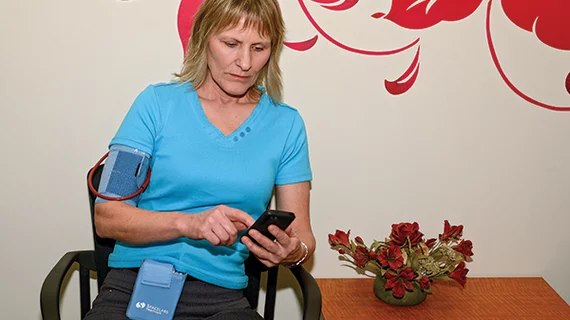3 days of home BP monitoring enough to confirm hypertension diagnosis
Three days’ worth of home blood pressure monitoring (HBPM) data is enough to confirm a diagnosis of clinical hypertension and initiate treatment, according to research published in the Journal of the American Heart Association this week.
The study, penned by lead author Natalie A. Bello, MD, MPH, and colleagues, assessed more than 300 adults from the IDH (Improving the Detection of Hypertension) trial in an effort to determine how many days patients with suspected high blood pressure should monitor their BP at home to corroborate a physician’s diagnosis of hypertension. Since some patients suffer from the “white coat effect”—the idea that medical settings induce anxiety, causing a person’s blood pressure to spike in the presence of doctors—the American College of Cardiology, American Heart Association and USPSTF recommend around a week of at-home monitoring before a patient begins treatment.
“There are few studies that have compared the reliability of different HBPM strategies that vary in the number of days HBPM is performed, the times of day BP is assessed and the number of measurements that are taken at each assessment,” Bello, of Columbia University Irving Medical Center in New York, and coauthors wrote in JAHA. “Based on expert opinion, several guidelines have recommended that two home BP readings be obtained by the patient in the morning and in the evening for a preferred period of seven days, with a minimum of three days of HBPM.”
In their study population of 316 adults who weren’t taking any antihypertensive medications at the trial’s baseline, the authors measured the reliability of HBPM and assessed hypertension status based on up to two weeks’ worth of BP measurements. Before the study began, all patients were screened for clinical hypertension by either a research nurse or technician, who performed three readings in each arm using a mercury sphygmomanometer, arm cuff and stethoscope.
The day after their baseline visit, participants received an Omron HEM-790IT or HEM-791IT—both automatic BP monitors that store all measurements electronically. Patients were fitted for an arm cuff and asked to take blood pressure measurements at home, twice after waking up and twice in the evening, allowing a minute between readings.
According to the study, the reliability of home BP monitoring was assessed using the intraclass correlation coefficient and as the percentage of participants with an absolute difference in blood pressure readings of less than 10 mm Hg between weeks.
Participants could track their blood pressure at home for up to three consecutive weeks, but the first two weeks of data were used for Bello et al.’s analysis. While just under 14 percent of patients were diagnosed with hypertension in the doctor’s office, 18 percent reported home hypertension.
Mean home BP was reliable using either the average of two morning and two evening BP readings for at least two days or the average of a single morning and evening reading for three days, the authors said. For diagnosing home hypertension, there was “good agreement” using at least three days’ worth of data, measuring BP at least once in the morning and once in the evening.
“A greater number of days was required to reliably estimate mean home BP and diagnose home hypertension for the other HBPM strategies,” Bello and colleagues said. “Healthcare providers can use these findings to interpret patient-provided home blood pressure monitoring data and determine whether an adequate number of out-of-office readings have been obtained or whether further monitoring is needed.”

